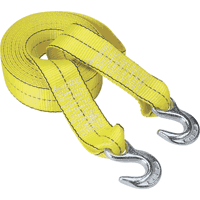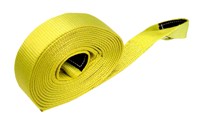|
|
|
| Danger – Do Not Use
Strap With Hooks |
Recommended
Strap With Loops |
Tow Straps:
The strap works like this. Say for example you are pulling out your friend, so you attach your recovery strap to the back of your vehicle and then to the front of his. As you drive away from him the recovery strap stretches just like a rubber band. The strap wants to go back to its normal size, so it has no other choice than to transfer the energy to the stuck vehicle, pulling it out.
Now then, imagine that great big rubber band with a big metal hook on the end of it? We’ve seen someone use a strap with a hook that came loose, shot forward, and put a big dent in the tailgate of the vehicle doing the pulling.
A tow strap is a very useful device made from nylon webbing. It is stretchable under tension. A tow strap allows one vehicle to assist another through a difficult spot from a distance of 20 or more feet away. By connecting the strap between the two vehicles, quite often winching can be avoided. When attaching the recovery strap to a vehicle, always use the towing hooks.
Quality winch accessory kits always include a recovery strap. Often, a stuck vehicle will be freed more easily with a tug than with the winch. Many strap designs provide a controlled stretch capable of reducing shock loads. Before unwinding yards of cable, try a pull with the recovery strap.
Tow straps come in various sizes, from 2″ wide to 4″ wide and lengths of up to 30 feet. A good high quality strap is preferred.
The recovery strap should be thought of as a large energy storage device. The strap will convert the kinetic (or speed energy) of the towing vehicle momentarily into spring potential energy. If all goes well, this energy is largely converted towards pulling out the stuck vehicle. However, if the anchor breaks loose, all of this massive energy is converted to high velocity energy of whatever weight remains attached.
For example, if the towing vehicle weighs 3,000 lbs. and is moving at just 10 mph when the anchor breaks, a 3 lb. shackle will become a cruise missile flying at over 300 mph. Just as a piece of straw can penetrate through a telephone pole at this speed during a tornado. So will the cruise missile strap blast through a vehicle. The message here is: If you’re going to use the recovery strap, know how it works.
It is this concept that makes shackles and anchor brackets a double-edged sword. We need to make them heavy to be strong, but this virtually demands very strong mounting. All of us who understand these concepts regarding recovery straps and anchors should do everything we can to help the novice off-roaders. Please do your part.
Broken recovery strap: This is not uncommon, especially if the nylon strap has been dragged over rocks or scraped across a sharp metal bumper edge and then put under severe stress. The temporary fix is a safe series of knots tying off damaged areas. For knot savvy, talk to a teamster, Navy recruit or an Eagle Scout.
When using a clevis with straps, make certain that nylon material rubs against the inside of the looped end. Otherwise, fraying and damage to the strap will result.
Strap Ratings:
| Web Capacity | Rated Capacity | Wd x Lg / App |
| 15,000 lbs | 15,000 lbs | 2″ x 20′ Mid-size trucks, jeeps |
| 20,300 lbs | 20,000 lbs | 2″ x 30′ Mid-size trucks, jeeps |
| 22,500 lbs | 22,500 lbs | 3″ x 20′ Mid-size trucks, jeeps |
| 30,500 lbs | 30,000 lbs | 3″ x 30′ Large 4 x 4 trucks |
| 40,700 lbs | 40,000 lbs | 4″ x 30′ Tractors, heavy equip |
| 61,000 lbs | 60,000 lbs | 6″ x 30′ Tractors, heavy equip |
Sample:
3-inch Nylon Webbing 3″ Webbing tensile 27,000 lbs. Breaking strength 21,600 lbs.
2-inch Nylon Webbing 2″ Webbing tensile 18,000 lbs. Breaking strength 14,400 lbs.
Towing With Chains:
In a word…don’t. Towing with a chain, in most cases, can be dangerous. Unlike a tow strap, a chain does not stretch. Under the tremendous loads of towing, something needs to have a little flexibility, hence the tow strap. By using a chain, there is nothing in the loop that will give a little. What this means, simply, is the weakest part will break once sufficient stresses are imposed. This could be the chain, the tow hook, or some other part of the vehicle. Can you imagine the force behind a chain link being thrown at you by a force of 8000 pounds? Chains have their place for the off-highway driver, but not in towing.
Choker Chain:
A term familiar to woodsmen and loggers, the choker is a high-tensile strength link chain with hooks at each end. A six- foot long choker chain is very versatile, acting as a vehicle recovery tool or reinforcement between two anchor points.
Tow Hooks:
Well mounted and well placed tow hooks are a necessity for any four wheeler. There is usually a great possibility that they will get used.
Factory or aftermarket front and rear frame-mounted tow hooks require high-tensile strength bolts and self-locking aircraft quality nuts. Attaching points and hardware must meet OE frame requirements. Never mount directly to the bumper. Hooks are available with spring clips to prevent straps from slipping off. These are especially useful for one-person operation. Mounted upward, downward or sideways, tow hook bolts should align in the direction of pull. Determine mounting location by the frame height, with the safest pull being a relatively straight line. Avoid welding tow hooks into place, even in a sound manner. These hooks may need replacement at some time.
Broken Tow Hooks:
This is a rare occurrence, but possible. If a frame-mounted hook breaks, a new cable attachment point is necessary. Using the choker chain as a new attachment point, wrap the chain around the frame or bumper supports, avoiding brake and fuel pipes, hoses and electrical wiring. (NOTE: Avoid attaching to the bumper, springs, hangers, suspension parts, axle or steering linkage.)
Preventive Maintenance:
Inspect all attaching hooks and straps. Make certain clevis pins are free of moisture, and lubricate them lightly. Dry out your nylon straps before storing them. Check tow hook and winch mount bolts and nuts for tightness and signs of fatigue. Inspect closely for bending or possible fatigue cracks on any parts affected by the winch loads. Pulleys (snatch block) should be cleaned and lubricated.
Recovery Operations:
In recovery operations, it is important that rigging be attached to the vehicle in such a manner as to avoid damage. For example, in recovery of a disabled 4X4 vehicle, the tow strap should not be attached to the bumper because the bumper might be damaged. The frame could be pulled out of alignment if the strap was attached where the effort was applied to a single frame member. Especially if pulling at an angle.
On 4X4 vehicles, whether the pull is made from the front or rear, the effort should be applied to the tow hooks. To apply the effort equally to tow hooks, a sling should be used between the two hooks and the effort applied to the sling. A chain is the best item to use as a sling. It’s a good idea to have a tow hook on each frame rail in order to pull evenly instead of on one rail.
Tow straps with hooks should not be used. The hook could come loose from the stuck vehicle and become a dangerous projectile towards the towing vehicle. Straps with looped ends should be used with the loops placed on the hook. Hooks should have retaining clips to keep the strap from sliding off. A towel should be placed over the strap between the vehicles to keep it from snapping back if the strap breaks.


